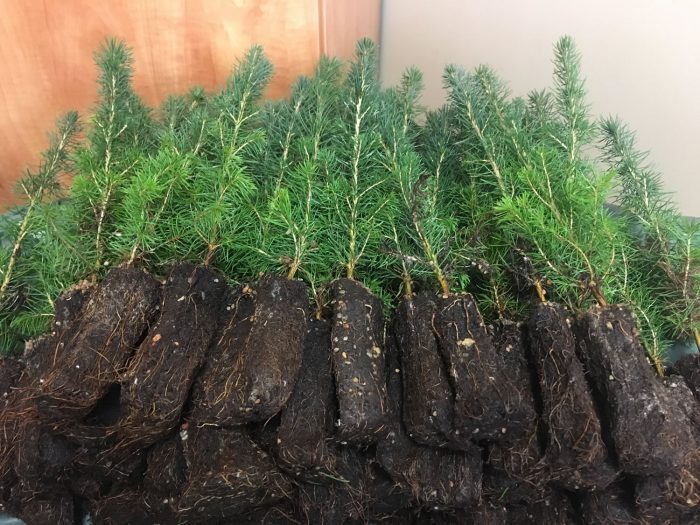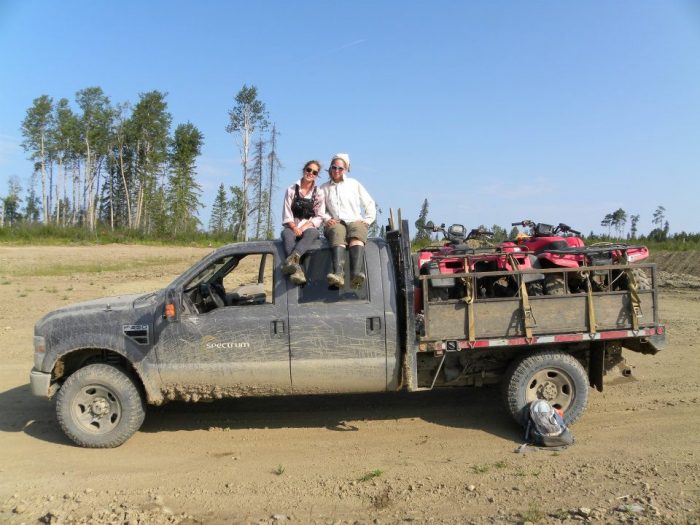Did you know that this year in Alberta 83 million seedlings were planted? That is a lot of tiny trees! All of these seedlings are safely in the ground thanks to the hard work and dedication of tree planters. Prior to the commencement of the planting season, forest companies that have previously harvested the area, hire tree planting companies who in turn hire tree planters to reforest the areas. During the summer months, tree planters work tirelessly to plant thousands of seedlings each day. Their commitment to the task results in the regeneration of harvested forest areas, restarting the cycle, keeping Alberta’s forests sustainable and renewable.

In this forestry career profile Laura Myers tells us about her experiences working as a tree planter as both a crew member and leader. Keep reading to find what it is like to work as a tree planter in British Columbia and Alberta.
Tell me about why you chose to plant trees.
I had finished my second year of university in BC, where tree planting is a common summer job for students. I had heard about tree planting from friends and decided this was an opportunity to explore as there was work for four months over the summer break (May-August). I had heard the work was tough, and that it was considered a right of passage for many Canadians. I was drawn to this because of the challenge in the work (physically, mentally, and environmentally).
Tell me about your role as a tree planter.
I was a tree planter for three seasons, a crew leader for one, and I also worked in other roles in forestry including aerial layout, monitoring and seismic surveying. Depending on the company you work for, you may be given the opportunity to do varying types of forestry work outside of planting. This allows for you to work for a longer period of time than the traditional spring plant (May – June) and summer plant (July – August), as other activities ran into September and seismic surveying ran from November to March.

From your experience, what characteristics do you think make a good tree planter?
Committing to accept the challenge is most important. You have to be determined to get through it. One of the hardest days could see you outside for 12 hours planting trees in snow or rain. Most tree planting camps are remote, which means you are sleeping in a tent for a period of three months. In June or July, the bugs come out, and you are challenged by the constant buzz of mosquitos while working. The goal is to work faster and keep moving, even when you don’t want to. A sense of humour is important in order to get through the tough days. Your planting colleagues become your family, as you all go through the same challenges together and play an important role in keeping spirits lifted and staying motivated. Some people are incredibly competitive, and will try to plant more trees every day, depending on the terrain, this may or may not be possible.
What are some of the challenges?
The biggest mental or emotional challenge for most is to be away from the world they know. Working locations are remote, often without cell service. Being away from the comforts of home can be tough. However, the opportunity to create lifelong friendships and disconnect from reality can be incredibly rewarding if you can learn to appreciate it.
Tree planting is also physically challenging. Your body becomes incredibly fit and muscular, as you are “bagging up” between 250-350 trees to plant per hour, often for over 8 hours a day. By day four or five of the shift you are physically tired, and welcome a day or two off to rest! The biggest challenge is certainly your “rookie year,’ learning how to space trees, and plant them well. Quality control is tough and it can take time for people to learn this. The first season is considered an “investment” year, by your 2nd and 3rd season, you can consistently plant 2300-2800 trees per day (trees are paid between 8 cents and 13 cents depending on the contract and terrain).

Was the work rewarding?
I continued to go back for a few years because I knew I could make decent money, disconnect from university life, and had a community that I enjoyed very much. The job was rewarding on a personal level as I made some of the best friendships I still carry over 10 years after first starting the job. On an individual level, the job rewarded me by helping me develop skills in resiliency, determination, and accomplishing goals. In five seasons in forestry, I explored parts of BC and Alberta I wouldn’t have been able to see had I not been working in the industry. Some work was so remote it required helicopter access on the BC/Alberta/Yukon border! I will never forget all the wildlife I saw over the years, including herds of bison, black and grizzly bears, lynx, moose and grouse to name a few.
Would you do it again?
As I am older, now I wouldn’t because it is so physical. However, if I went back to my early 20s absolutely, it’s a great area to work in while you are young, fit, and trying to understand your role and place in the world. The good memories I have outweigh the challenges I faced during each season. The friends I made continue to be important people in my life today.
Any advice for students or others considering this opportunity?
Ask yourself why you want to do the job. Many people believe that money is the only reason to pursue this job, because the incentive is there (plant a lot of trees, make a lot of money). I would suggest going deeper than the financial incentive, to look at personal characteristics, and whether you can handle really tough days in the field. Talk to people who have worked in this area, find companies that are hiring. My advice, try to find a small to medium sized company, the largest companies are a great starting place; however, the price per contract could be lower than with a smaller company due to overhead, camp costs, etc.
How was the transition from crew member to crew leader?
I thoroughly enjoyed leading a crew, it taught me great management and people skills as your crew are a family you take care of. Watching rookies grow from planting 1000 trees per day, to hitting 2000 was amazing. Seeing the team grow on an individual basis was also amazing; your role changes from just being one of the team, to being the biggest encourager and supporter for your team. Leading a crew came with more responsibilities, such as driving, loading trees, setting up pieces, and ensuring your planters were well supported and doing their jobs with appropriate quality. I worked the hardest I have ever worked, a usual day started at 5 am, and did not finish until 10 pm. It made me really appreciate when I was just planting trees when my day finished after my last tree was in the ground.
Walk me through a typical day.
As a planter:
5:30 – 6:00 am – Wake up, eat breakfast, and pack lunch.
6:00 – 6:30 am – Depart for block (the drive could be anywhere from 20 minutes to 1 hour).
6:30 am – Arrive at block, safety chat, and team meeting.
7:00 am – Start planting! Aim for 1 bag up per 50 minutes.
5:00 pm – Finish, meet at the trucks, talk about how great or awful your day was.
6:00 pm – Dinner at camp (if you are staying in hotels you have to cook for yourself)
Evening – Up to you how you spend it. Some activities include: campfires, hanging out, stretching, and fixing your boots!
You would repeat that schedule for 4 or 5 days followed by 1 or 2 days off to do laundry, shower, rest, etc. If you are staying in a bush camp then showers are on site and meals are prepared for you on site as well.
Was there anything unexpected about your experience or role?
I was surprised by the diversity of people who were in the job. People came to tree plant from all over Canada, from all different backgrounds and age ranges (from 18 to 35 mostly). Some of these people were lifelong planters and others were students.
Also, it took me a long time to become a “quick” planter. In my second year I switched companies and a vet challenged me every day to get my numbers up. I remember thinking 3000 trees in a day was impossible but with the right planters around you, you can get up there!

What was it like working in a role where you could so tangibly see the results?
Going past a block a year or two after you have planted was very cool, you can see the trees that survive and are starting to grow. I would say most results would be seen about four to six years after planting, as the trees have started to grow much more noticeably.
Did this position influence your career path?
I wouldn’t say this role directly influenced my career path. It did however give me many transferable skills that were applied to challenging jobs as I finished university. I started my career working in rural West Africa in a remote town without many of the basic necessities we have in North America. The role also taught a lot about resilience and determination required to accomplish goals both professional and personal. Working with diverse groups now, I find that I can use humour to support us through challenging times. I currently work as a project manager, which means I can manage diverse teams and my role is to ensure I support them in accomplishing their goals. I see great value in the skills of forestry work being applied to other areas of life.
To learn more about tree planting and to apply for this rewarding job, visit: www.tree-planter.com.